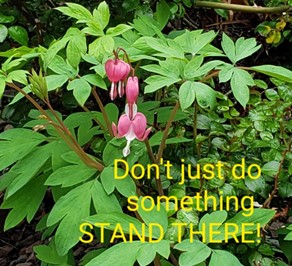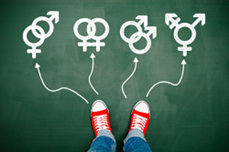Home > Standing in Affirmation for Pride Month
By Cele Fichter-DeSando, MPM (She Her, Hers)
Overview
Lesbian, Gay, Bisexual, Transgender, Queer, Intersex, and Asexual+ (LGBTQIA+) Pride Month is celebrated each June to honor the 1969 Stonewall Uprising in Manhattan and the continued efforts to achieve equal justice and equal opportunity for LGBTQIA+ Americans (Library of Congress, loc.gov/lgbt-pride-month/about/). Many US cities and other countries have month-long series of events and celebrations that include pride parades, parties, workshops, and concerts. In addition, memorials are held during June for those members of the community who have been lost to hate crimes or HIV/AIDS.
Pride Month occurs during the sixth month of the calendar year providing us with an opportunity for mid-year reflection and the re-establishment of a commitment to LGBTQIA+ affirming goals, activities, and services.
Around the time of the 1969 Stonewall Uprising, my sister and I were given a poster for our bedroom wall that read “Don’t Just Do Something - Stand There.” At that time, I wasn’t quite smart enough to know what the poster meant, but I was smart enough to know that it meant something important.

The Process of Affirmation
Over the years as a prevention practitioner, I have come to understand that we must both do something and stand there. Our actions must be rooted in best practice, thoughtfully planned, and carried out with conviction. When witnessing pain, trauma, and injustice it is often necessary to rush to immediate action and assistance but it is also necessary to not get caught up in just doing one-time services. We must use research, and resources to plan best practices for life-changing future action. To achieve safety, health, well-being, equity, and reduced disparities and trauma for LGBQIA+ individuals, families, and communities we need to provide both immediate “do something” action and an affirmative “stand there” stance. Together we must plan, gather information, collaborate, and implement evidence-based programs for long-term change. Many times, doing something comes easily, it is the standing there that is much harder to achieve.
In the classic book, Born Only Once, Psychiatrist Conrad Baars, MD describes affirmation as a dynamic state of being. “The affirming process can be compared in a certain sense to the effect water has on an object immersed in it. The water surrounds it perfectly and adjusts itself faithfully to the exact contours of the object without destroying it. It allows the object, if a living one, like fish, coral, or plant, to grow and develop without hindrance by adjusting its own weight in relation to it. The water cushions with its mass and density any shocks or blows it might receive and thus protects the object.” (Barrs, 2016, pp. 14-15).
As educators, providers, and prevention practitioners we can be that affirming water that provides a safe, supportive space for LGBTQIA+ individuals to live, learn, participate in, and receive evidence-based care and services.
LGBTQIA+ Resources
There are many resources to help organizations and communities plan, provide services and continue their efforts to achieve justice and reduce disparities for LGBTQIA+ individuals of all ages.
The Center of Excellence on LGBTQ+ Behavioral Health Equity, (Center) provides behavioral health practitioners with vital information on supporting the population of people identifying as lesbian, gay, bisexual, transgender, queer, questioning, intersex, two-spirit, and other diverse sexual orientations, gender identities, and expressions.

According to The Center’s website, current disparities and disproportionalities data on LGBTQIA+ communities highlight the importance of more tailored and culturally responsive substance use and mental health services throughout the lifespan. LGBTQIA+ populations of all ages disproportionately experience more instances of mental health and substance use disorders, suicidality, and poor well-being outcomes compared to their heterosexual and cisgender peers. The Center cites that behavioral health disparities experienced by LGBTQIA+ populations can be attributed to:
The Center of Excellence on LGBTQ+ Behavioral Health Equity provides educational resources, webinars, and technical assistance for providers and communities to increase awareness and understanding, increase practitioner knowledge and skills, and accelerate the adoption and implementation of evidence-based practice.
SAMHSA Lesbian, Gay, Bisexual, Transgender, Queer, and Intersex (LGBTQI+) Resources SAMHSA Resources on the LGBT population include national survey reports, agency and federal initiatives, and related behavioral health resources. A recent SAMHSA blog post, LGBTQI+ Youth – Like All Americans, They Deserve Evidence-Based Care by Assistant Secretary for Mental Health and Substance Use, Miriam E. Delphin-Rittmon, Ph.D., provides information about what works to best engage LGBTQI+ youth as well as resources for them, their families, providers, community organizations, and government agencies.
Resources | Lesbian, Gay, Bisexual, and Transgender Health | CDC - The Centers for Disease Control and Prevention (CDC) provides general information, data resources, and links to LGBTQ+ health-related organizations and coalitions.
LGBTQ Youth Resources | Lesbian, Gay, Bisexual, and Transgender Health | CDC

The CDC provides LGBTQ Youth specific resources and contacts for other government agencies, and community organizations for LGBT Youth, their friends, educators, parents, and family members to support positive environments.
A Practitioner's Resource Guide: Helping Families to Support Their LGBT Children - This resource guide offers information and resources to help practitioners in health and social service systems implement best practices to engage and help families and caregivers support their lesbian, gay, bisexual, and transgender (LGBT) children.
Gender-Affirming Care Is Trauma-Informed Care - Fact sheet provided by the National Child Traumatic Stress Network with resources and suggestions for creating accepting and supportive environments that provide gender-affirming care as the standard of care for transgender, gender diverse, and intersex (TGI) youth.
LGBTQI Youth - Healthy People 2030 | health.gov - More U.S. high school students who self-identify as lesbian, gay, or bisexual say they’ve been bullied on school property and cyberbullied than their heterosexual peers. This website offers information and resources about bullying of LGBT young people and how to help them, including:
Stand Against Stigma Challenge - The Substance Abuse and Mental Health Services Administration-funded Opioid Response Network (ORN) initiative has launched the Stand Against Stigma (SAS) Challenge. This is an opportunity for individuals, communities, and organizations, particularly those working in justice/law and healthcare systems, to address and dispel stigma related to individuals with substance use disorders through easy, daily activity.
Conclusion: This June, let’s do something and stand there in affirmation for LGBTQIA+ safety, justice, and health equity. Take the time to do mid-year reflections on your personal and organizational goals. Take this opportunity to make any mid-course adjustments necessary to provide a wide range of evidence-based resources, services, and practices in safe, welcoming, and supportive environments.
Author's Contact Info:
Cele Fichter-DeSando, MPM (She, Her, Hers)
7069 Highland Creek Drive
Bridgeville PA, 15017
[email protected]
412-580-3089
References
Barrs, Conrad. (2016). Born Only Once, The Miracle of Affirmation. Third Edition. WIPF & STOCK / 2016.
Center of Excellence on LGBTQ Equity 2022. Improving Care for LGBTQ+ Communities. Retrieved May 9, 2022. https://lgbtqequity.org/
Delphin-Rittman, Miriam. SAMHSA. LGBTQI+ Youth – Like All Americans, They Deserve Evidence-Based Care. March 30, 2022. https://www.samhsa.gov/blog/lgbtqi-youth-all-americans-deserve-evidence-based-care?utm_source=SAMHSA&utm_campaign=ce31a21a0e-SAMHSA_Announcement_2022_03_31_1600949&utm_medium=email&utm_term=0_ee1c4b138c-ce31a21a0e-169226202
Healthy People 2030. LGBTQI Youth
Retrieved on May 9, 2022. https://health.gov/healthypeople/tools-action/browse-evidence-based-resources/lgbtqi-youth
Library of Congress. 2022. Lesbian, Gay, Bisexual, Transgender, and Queer Pride Month
Retrieved on May 9, 2022. https://www.loc.gov/lgbt-pride-month/